High-Resolution Analysis of Temporal Variation and Driving Factors of CO2 Concentration in Nanning City in Spring 2024
Abstract
1. Introduction
2. Materials and Methods
2.1. Monitoring Location
2.2. Experimental Instruments
2.3. Data Processing
3. Results and Discussion
3.1. Characteristics of CO2 Concentration Variations in Nanning
3.1.1. Diurnal Variation of CO2 Concentrations in Nanning
3.1.2. Monthly Variation of CO2 Concentrations in Nanning
3.2. Analysis of Influencing Factors
3.2.1. Screening Analysis of CO2 Concentrations
3.2.2. Source Attribution of CO2 Concentrations via Back-Trajectory Simulation
3.2.3. Meteorological Factor Correlation Analysis
- (1)
- Correlation Analysis Between CO2 and Wind Direction/Speed
- (2)
- Correlation Analysis Between CO2 and Temperature/Humidity
4. Conclusions
Author Contributions
Funding
Institutional Review Board Statement
Informed Consent Statement
Data Availability Statement
Conflicts of Interest
References
- Wigley, T.M.L. The Kyoto Protocol: CO2 CH4 and climate implications. Geophys. Res. Lett. 1998, 25, 2285–2288. [Google Scholar] [CrossRef]
- Peters, G.P.; Marland, G.; Le Quéré, C.; Boden, T.; Canadell, J.G.; Raupach, M.R. Rapid growth in CO2 emissions after the 2008–2009 global financial crisis. Nat. Clim. Change 2012, 2, 2–4. [Google Scholar] [CrossRef]
- Jiang, H.; Yin, J.; Wei, D.; Luo, X.; Ding, Y.; Xia, R. Industrial carbon emission efficiency prediction and carbon emission reduction strategies based on multi-objective particle swarm optimization-backpropagation: A perspective from regional clustering. Sci. Total Environ. 2024, 906, 167692. [Google Scholar] [CrossRef] [PubMed]
- Li, L.; Lei, Y.; Wu, S.; He, C.; Chen, J.; Yan, D. Impacts of city size change and industrial structure change on CO2 emissions in Chinese cities. J. Clean. Prod. 2018, 195, 831–838. [Google Scholar] [CrossRef]
- Kordowski, K.; Kuttler, W. Carbon dioxide fluxes over an urban park area. Atmos. Environ. 2010, 44, 2722–2730. [Google Scholar] [CrossRef]
- Svirejeva-Hopkins, A.; Schellnhuber, H.J.; Pomaz, V.L. Urbanised territories as a specific component of the Global Carbon Cycle. Ecol. Model. 2004, 173, 295–312. [Google Scholar] [CrossRef]
- Nathan, B.; Lauvaux, T.; Turnbull, J.; Gurney, K. Investigations into the use of multi-species measurements for source apportionment of the Indianapolis fossil fuel CO2 signal. Elem. Sci. Anthr. 2018, 6, 21. [Google Scholar] [CrossRef]
- Lian, J.; Lauvaux, T.; Utard, H.; Bréon, F.M.; Broquet, G.; Ramonet, M.; Laurent, O.; Albarus, I.; Chariot, M.; Kotthaus, S.; et al. Can we use atmospheric CO2 measurements to verify emission trends reported by cities? Lessons from a 6-year atmospheric inversion over Paris. Atmos. Chem. Phys. 2023, 23, 8823–8835. [Google Scholar] [CrossRef]
- Lauvaux, T.; Gurney, K.R.; Miles, N.L.; Davis, K.J.; Richardson, S.J.; Deng, A.; Nathan, B.J.; Oda, T.; Wang, J.A.; Hutyra, L.; et al. Policy-Relevant Assessment of Urban CO2 Emissions. Environ. Sci. Technol. 2020, 54, 10237–10245. [Google Scholar] [CrossRef]
- Asimow, N.G.; Turner, A.J.; Cohen, R.C. Sustained Reductions of Bay Area CO2 Emissions 2018–2022. Environ. Sci. Technol. 2024, 58, 6586–6594. [Google Scholar] [CrossRef]
- Xuebin, S.; Le, H.; MIN, L. Time Series Variation of Ambient Air Carbon Dioxide Concentration in Shenyang City and Its Correlation With Meteorology. J. Green Sci. Technol. 2022, 24, 221–225. [Google Scholar]
- Glaeser, E.L.; Kahn, M.E. The greenness of cities: Carbon dioxide emissions and urban development. J. Urban Econ. 2010, 67, 404–418. [Google Scholar] [CrossRef]
- Imasu, R.; Tanabe, Y. Diurnal and Seasonal Variations of Carbon Dioxide (CO2) Concentration in Urban, Suburban, and Rural Areas around Tokyo. Atmosphere 2018, 9, 367. [Google Scholar] [CrossRef]
- Mallia, D.V.; Mitchell, L.E.; Gonzalez Vidal, A.E.; Wu, D.; Kunik, L.; Lin, J.C. Can We Detect Urban-Scale CO2 Emission Changes Within Medium-Sized Cities? J. Geophys. Res. Atmos. 2023, 128, e2023JD038686. [Google Scholar] [CrossRef]
- Yinchao, C.; Wei, H.; Wenke, G.; Bingqiang, F.; Xiaohua, M.; Yaling, D. Space Distribution Characteristics of Near-surface CO2: Concentration in Summer of Urumqi. Environ. Sci. Technol. 2018, 41, 22–27. [Google Scholar] [CrossRef]
- Chang, G.; Fang, C.; Feng, X.; Changliu, W.; Yuxian, Z.; Hanyu, L.; Yanlin, Z. Characteristics of atmospheric CO2 concentration and stable carbon isotopic composition in Nanjing in summer: Effects of anthropogenic emission changes. Trans. Atmos. Sci. 2024, 1–18. [Google Scholar] [CrossRef]
- Fang, S.; Du, R.; Qi, B.; Ma, Q.; Zhang, G.; Chen, B.; Li, J. Variation of carbon dioxide mole fraction at a typical urban area in the Yangtze River Delta, China. Atmos. Res. 2022, 265, 105884. [Google Scholar] [CrossRef]
- Ningzhang, W.; Ming, L.; Wenzhao, L.; Jianqiong, W.; Baoxin, L.; Lei, R. Variation Characteristics of CO2, and CH4 Concentrations in Waliguan Area in 2019 and Potential Source Analysis. Adv. Meteorol. Sci. Technol. 2023, 13, 17–23. [Google Scholar]
- Yuting, P.; Honghui, X.; Meng, S.; Jingjiao, P.; Yilei, D. Background characteristics and source analysis of CO2 concentration in the Yangtze River Delta. Acta Sci. Circumstantiae 2023, 43, 340–353. [Google Scholar] [CrossRef]
- Hong, W.; Ma, T.; Guo, R.; Yang, X.; Li, X.; Sun, M.; Chen, Y.; Zhong, Y. Carbon emission characteristics of urban trip based on multi-layer network modeling. Appl. Geogr. 2023, 159, 103091. [Google Scholar] [CrossRef]
- Wen, H.; Huizhi, L.; Feng, J.W. Characteristics of turbulent fluxes and carbon dioxide flux over urban surface layer. Clim. Environ. Res. 2010, 15, 21–33. [Google Scholar]
- Helfter, C.; Tremper, A.H.; Halios, C.H.; Kotthaus, S.; Bjorkegren, A.; Grimmond, C.S.B.; Barlow, J.F.; Nemitz, E. Spatial and temporal variability of urban fluxes of methane, carbon monoxide and carbon dioxide above London, UK. Atmos. Chem. Phys. 2016, 16, 10543–10557. [Google Scholar] [CrossRef]
- Yanhong, J.; Xiaoqian, S.; Heran, L. Characteristic analysis of climate change in Nanning from 1991 to 2020. J. Guangxi Norm. Univ. 2023, 41, 190–200. [Google Scholar] [CrossRef]
- Weissert, L.F.; Salmond, J.A.; Turnbull, J.C.; Schwendenmann, L. Temporal variability in the sources and fluxes of CO2 in a residential area in an evergreen subtropical city. Atmos. Environ. 2016, 143, 164–176. [Google Scholar] [CrossRef]
- Park, C.; Jeong, S.; Park, H.; Sim, S.; Hong, J.; Oh, E. Comprehensive assessment of vertical variations in urban atmospheric CO2 concentrations by using tall tower measurement and an atmospheric transport model. Urban Clim. 2022, 45, 101283. [Google Scholar] [CrossRef]
- Bezyk, Y.; Górka, M.; Sówka, I.; Nęcki, J.; Strąpoć, D. Temporal dynamics and controlling factors of CO2 and CH4 variability in the urban atmosphere of Wroclaw, Poland. Sci. Total Environ. 2023, 893, 164771. [Google Scholar] [CrossRef]
- Pu, J.-J.; Xu, H.-H.; He, J.; Fang, S.-X.; Zhou, L.-X. Estimation of regional background concentration of CO2 at Lin’an Station in Yangtze River Delta, China. Atmos. Environ. 2014, 94, 402–408. [Google Scholar] [CrossRef]
- Zhang, J.; Zhang, C.; Dong, H.; Zhang, L.; He, S. Spatial–Temporal Change Analysis and Multi-Scenario Simulation Prediction of Land-Use Carbon Emissions in the Wuhan Urban Agglomeration, China. Sustainability 2023, 15, 11021. [Google Scholar] [CrossRef]
- Gratani, L.; Varone, L. Daily and seasonal variation of CO2 in the city of Rome in relationship with the traffic volume. Atmos. Environ. 2005, 39, 2619–2624. [Google Scholar] [CrossRef]
- Yuanlai, H. Analysis of Spatiotemporal Changes in Environmental Air Quality in Nanning Urban Area From 2018 to 2022. J. Green Sci. Technol. 2023, 25, 139–143. (In Chinese) [Google Scholar] [CrossRef]
- Ping, C.; Xinying, Z.; Lisong, T.; Niyu, W.; Yufeng, W.; Benhao, Z. Tempo-spatial Distribution of Air Pollution Index of Nanning City. J. Guangxi Teach. Educ. Univ. Nat. Sci. Ed. 2016, 33, 66–72. (In Chinese) [Google Scholar] [CrossRef]
- Büns, C.; Kuttler, W. Path-integrated measurements of carbon dioxide in the urban canopy layer. Atmos. Environ. 2012, 46, 237–247. [Google Scholar] [CrossRef]
- Zhang, L.; Zhang, H.; Li, Q.; Wu, B.; Cai, X.; Song, Y.; Zhang, X. Complexity of carbon dioxide flux in urban areas: A comparison with natural surfaces. Sci. Total Environ. 2023, 895, 165115. [Google Scholar] [CrossRef] [PubMed]
- García, A.G.; Di Bella, C.M.; Houspanossian, J.; Magliano, P.N.; Jobbágy, E.G.; Posse, G.; Fernández, R.J.; Nosetto, M.D. Patterns and controls of carbon dioxide and water vapor fluxes in a dry forest of central Argentina. Agric. For. Meteorol. 2017, 247, 520–532. [Google Scholar] [CrossRef]
- Chen, L.; Xiao, W.; Yang, F.; Shan, M.; Wang, J.; Hu, N.; Li, R.; Cheng, K. Vertical variations of CO2/CH4 in winter based on observations at high-rise buildings in Shanghai. China Environ. Sci. 2024, 44, 4155–4166. [Google Scholar] [CrossRef]
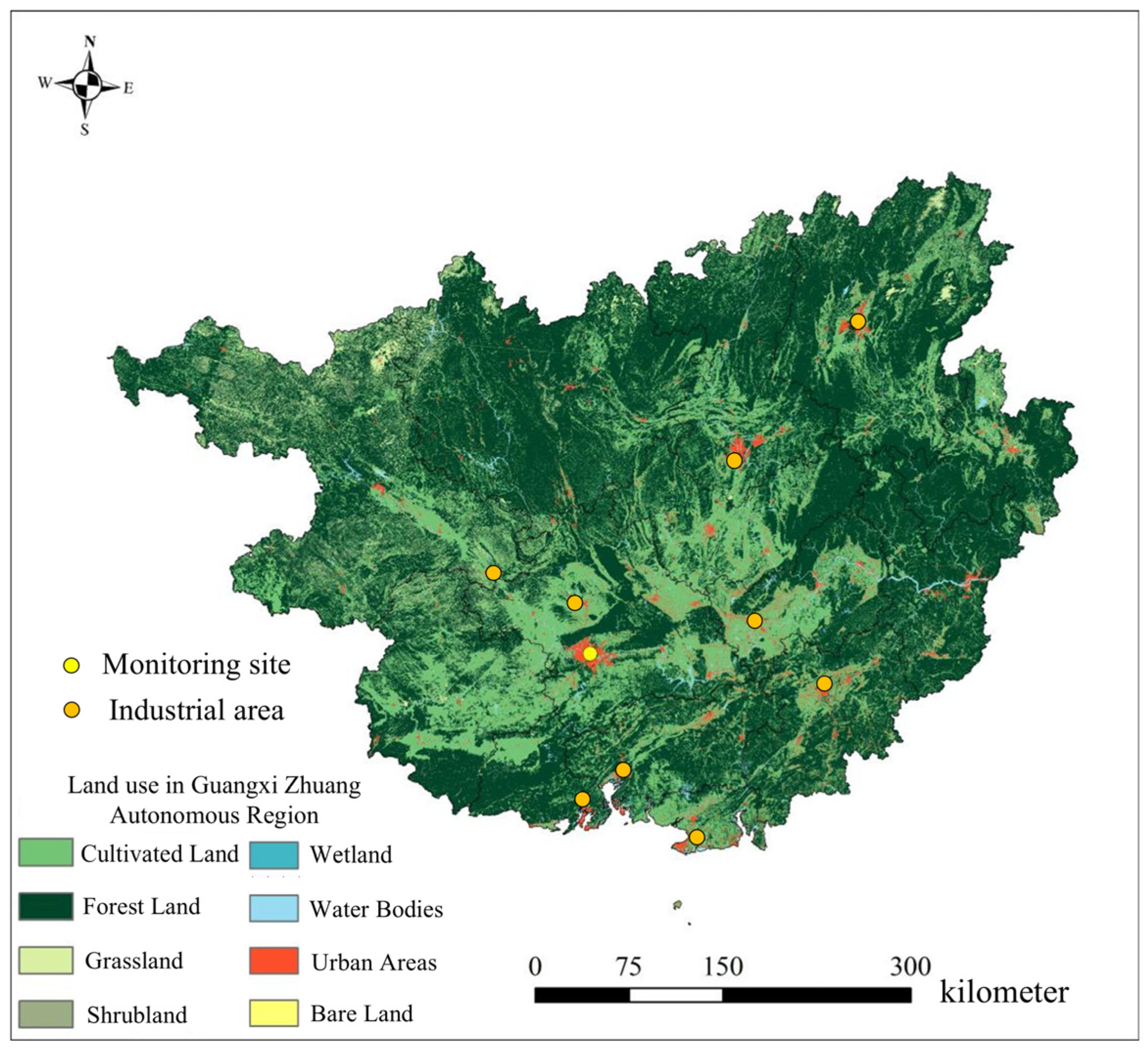
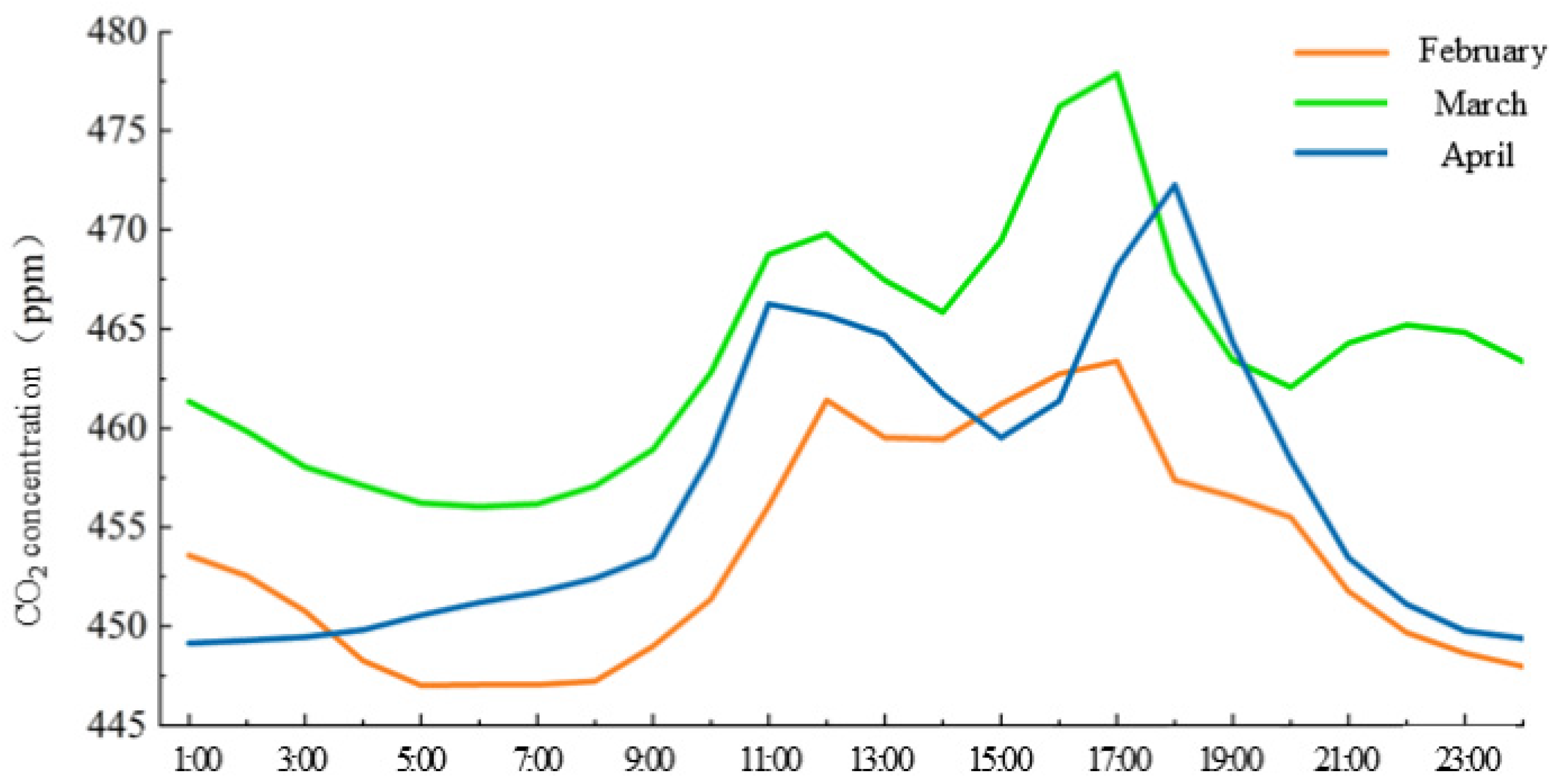
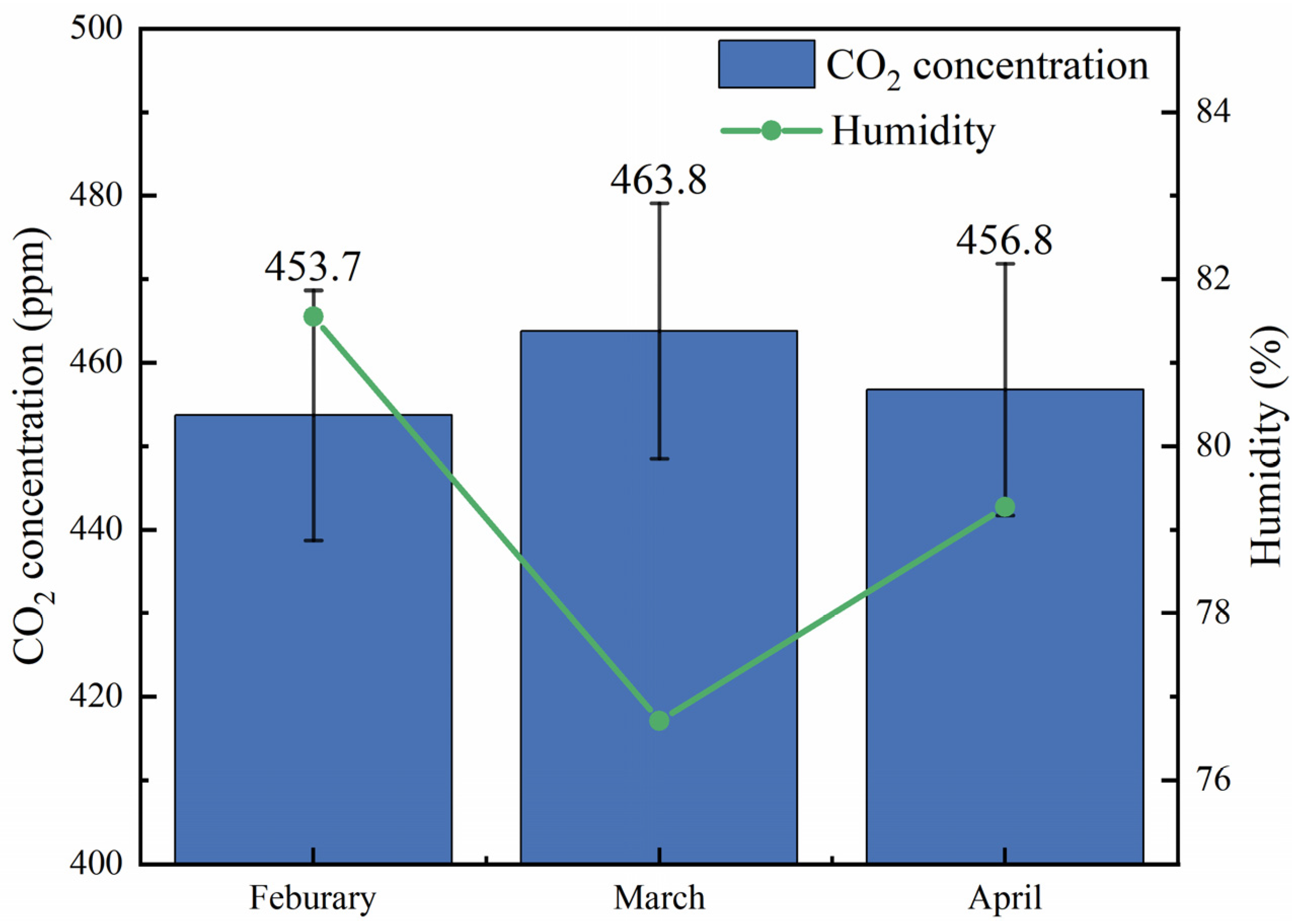
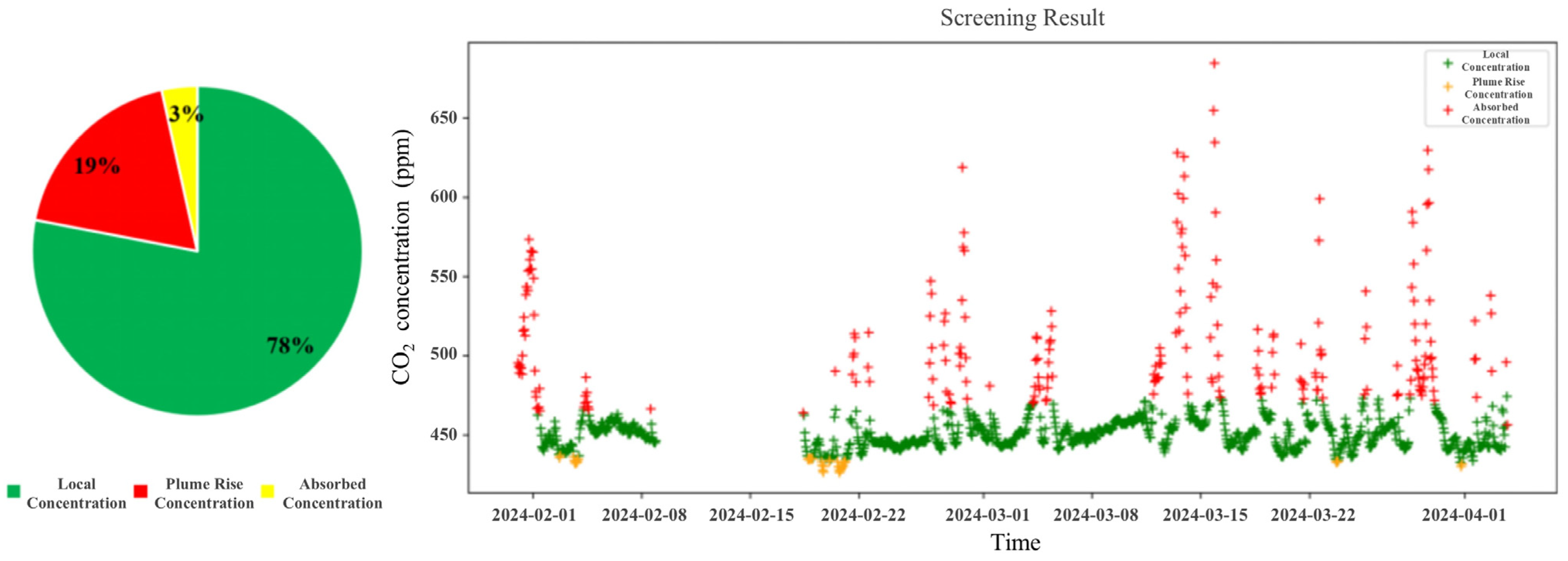
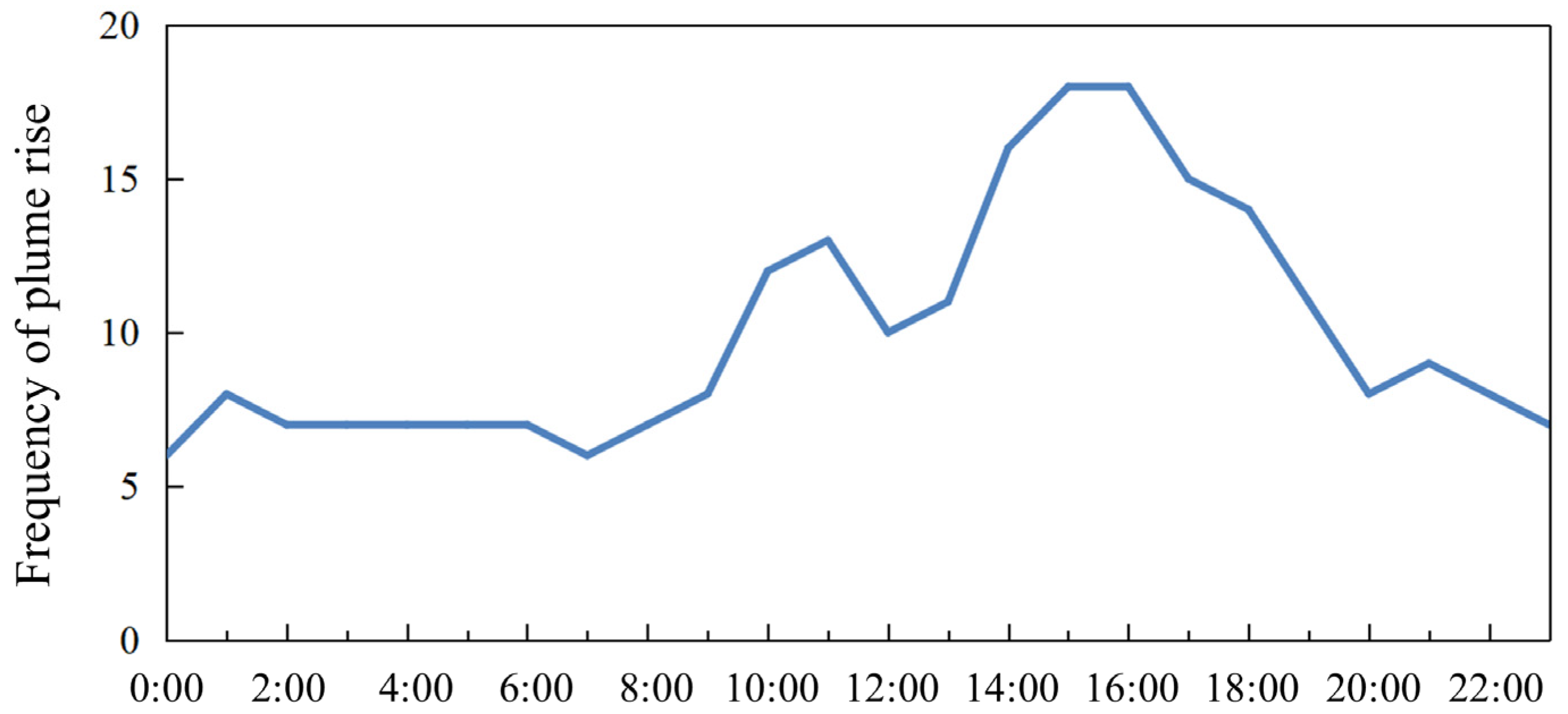
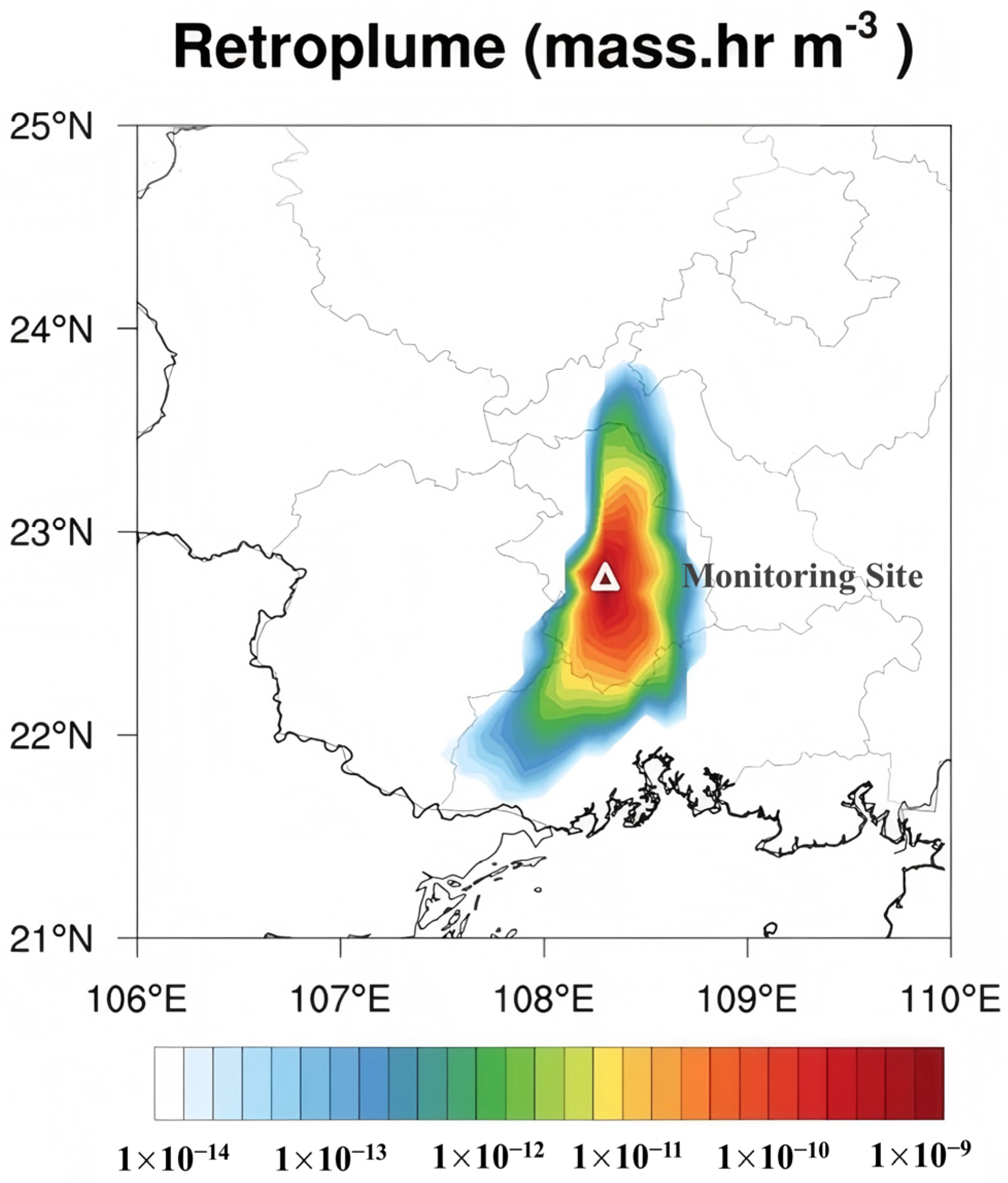
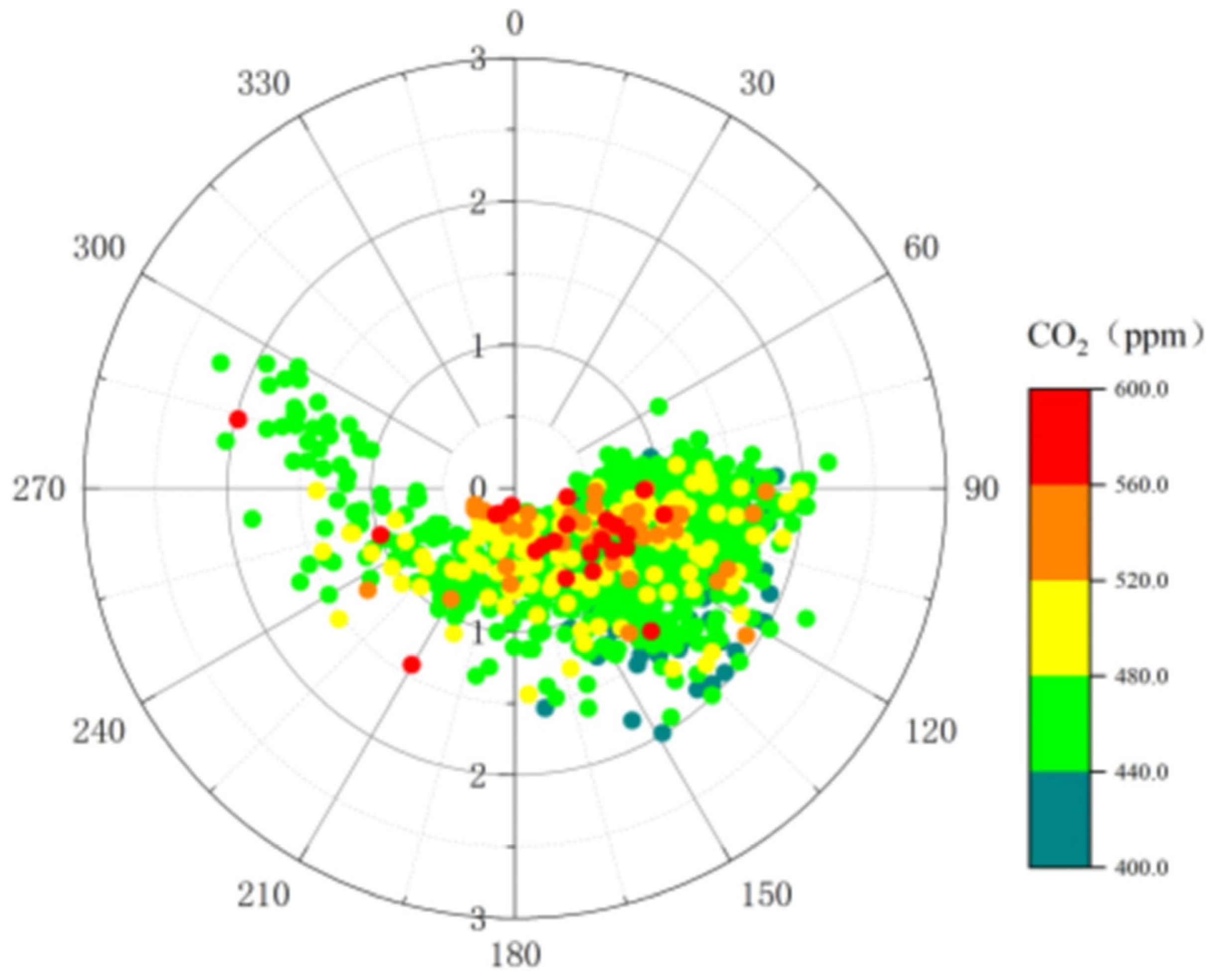
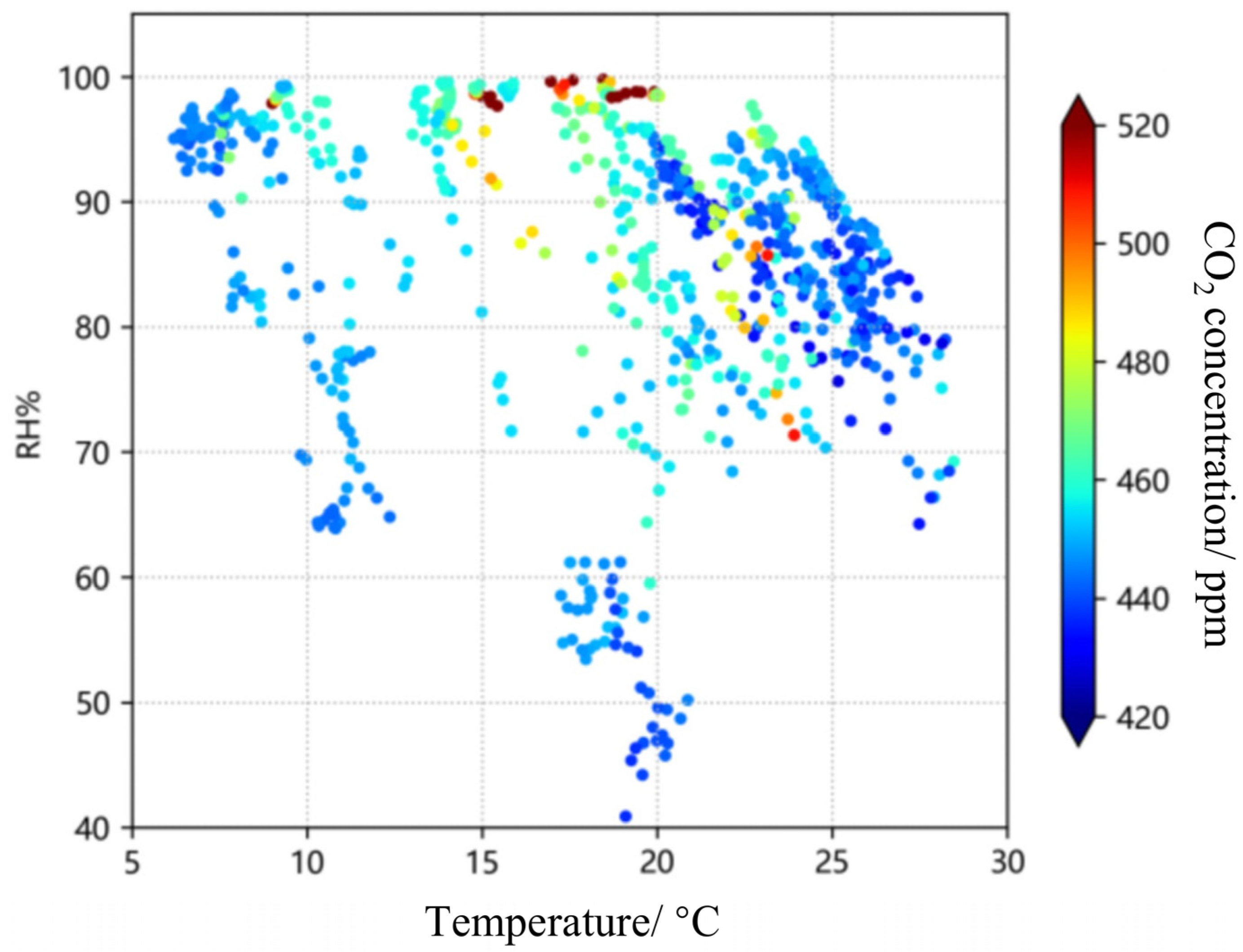
Disclaimer/Publisher’s Note: The statements, opinions and data contained in all publications are solely those of the individual author(s) and contributor(s) and not of MDPI and/or the editor(s). MDPI and/or the editor(s) disclaim responsibility for any injury to people or property resulting from any ideas, methods, instructions or products referred to in the content. |
© 2025 by the authors. Licensee MDPI, Basel, Switzerland. This article is an open access article distributed under the terms and conditions of the Creative Commons Attribution (CC BY) license (https://creativecommons.org/licenses/by/4.0/).
Share and Cite
Feng, J.; Chen, X.; Liu, H.; Mo, Z.; Yan, S.; Peng, X.; Li, H.; Li, H.; Liao, H.; Lu, J. High-Resolution Analysis of Temporal Variation and Driving Factors of CO2 Concentration in Nanning City in Spring 2024. Atmosphere 2025, 16, 449. https://doi.org/10.3390/atmos16040449
Feng J, Chen X, Liu H, Mo Z, Yan S, Peng X, Li H, Li H, Liao H, Lu J. High-Resolution Analysis of Temporal Variation and Driving Factors of CO2 Concentration in Nanning City in Spring 2024. Atmosphere. 2025; 16(4):449. https://doi.org/10.3390/atmos16040449
Chicago/Turabian StyleFeng, Jinghang, Xuemei Chen, Huilin Liu, Zhaoyu Mo, Shiyang Yan, Xiaoyu Peng, Hongjiao Li, Hao Li, Hui Liao, and Jiahui Lu. 2025. "High-Resolution Analysis of Temporal Variation and Driving Factors of CO2 Concentration in Nanning City in Spring 2024" Atmosphere 16, no. 4: 449. https://doi.org/10.3390/atmos16040449
APA StyleFeng, J., Chen, X., Liu, H., Mo, Z., Yan, S., Peng, X., Li, H., Li, H., Liao, H., & Lu, J. (2025). High-Resolution Analysis of Temporal Variation and Driving Factors of CO2 Concentration in Nanning City in Spring 2024. Atmosphere, 16(4), 449. https://doi.org/10.3390/atmos16040449




